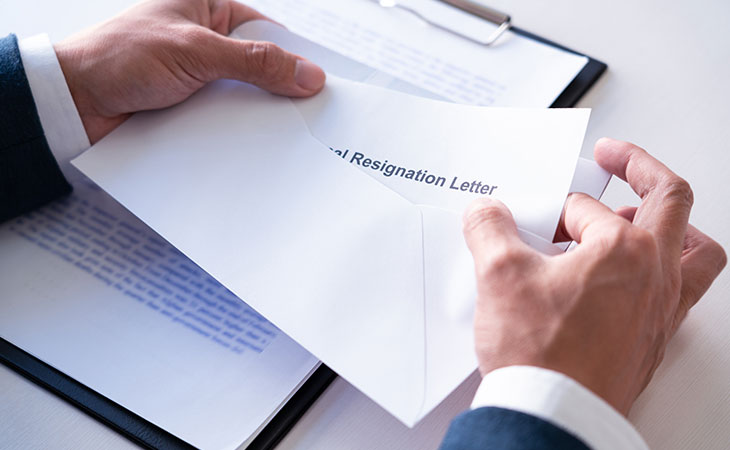Resigning from a job is a significant step in your career, and how you communicate that decision is crucial. Writing a well-crafted resignation letter is more than just a formality—it’s an opportunity to leave your current role on a positive note, maintain professional relationships, and set the stage for future opportunities.
In this post, we’ll guide you through every step of writing a resignation letter, from preparation to the final touches. You’ll learn how to structure your letter, what content to include, and how to avoid common mistakes. Whether you’re moving on to a new opportunity or stepping back for personal reasons, this comprehensive guide will help you write a resignation letter that reflects your professionalism and respect for your current employer. Keep reading to ensure your resignation is handled with grace and leaves a lasting, positive impression.
Contents
- Chapter 1: Preparing to Write Your Resignation Letter
- Chapter 2: Structuring Your Resignation Letter
- Chapter 3: How to Write the Opening Paragraph
- Chapter 4: How to Write the Body of the Letter
- Chapter 5: How to Write the Closing Paragraph
- Chapter 6: Tips for Writing a Resignation Letter
- Chapter 7: Common Mistakes to Avoid
- Chapter 8: Examples of Resignation Letters
- Conclusion
Chapter 1: Preparing to Write Your Resignation Letter
Writing a resignation letter is a significant step in your career journey, signaling the end of one chapter and the beginning of another. However, before you put pen to paper, it’s essential to take the time to prepare thoroughly. This chapter will guide you through the critical preparatory steps that will not only make the process smoother but also ensure that you leave your current role on the best possible terms. By the end of this chapter, you’ll have a clear understanding of the practical and emotional aspects of resigning, setting the stage for crafting a professional and thoughtful resignation letter.
Here, we will explore key factors to consider before writing your resignation letter. From assessing your situation to planning your transition and keeping your decision confidential, each step plays a vital role in ensuring a respectful and organized exit from your current position. Whether you’re leaving for a new opportunity or stepping back for personal reasons, the preparation you do now will make all the difference in how you’re remembered and how smoothly you move on to your next endeavor.
Assess Your Situation
Before drafting your resignation letter, it’s crucial to thoroughly assess your current situation. Consider the reasons for your decision to leave—is it due to career advancement, personal reasons, or dissatisfaction with your current role? Understanding the underlying motivations will help you articulate your departure more clearly and ensure that your decision aligns with your long-term career goals.
Moreover, take the time to evaluate the potential impact of your resignation. How will this decision affect your financial situation, your professional reputation, and your relationships within the company? By thoroughly assessing your situation, you can approach your resignation with confidence and a clear mind, ensuring that your decision is the right one for you at this point in your career.
Check Company Policies
Every company has its own set of policies regarding resignations, and it’s essential to familiarize yourself with these before proceeding. Review your employee handbook or consult with HR to understand the notice period required, any contractual obligations, and the proper procedures for submitting a resignation letter. This step ensures that you comply with all formalities and avoid any legal or professional repercussions.
Additionally, checking company policies can provide insight into how your resignation might be handled by your employer. For example, some companies may have a non-compete clause or require an exit interview. Being aware of these aspects allows you to be better prepared for what comes next and helps you navigate the resignation process smoothly.
Gather Necessary Information
Before writing your resignation letter, gather all the necessary information that you’ll need to include. This might include your official job title, the correct spelling of your manager’s name, and details about any projects you’re currently working on. Having this information at your fingertips will make the writing process more efficient and ensure that your letter is accurate and complete.

Furthermore, gathering information extends to understanding your outstanding benefits and entitlements. This could involve checking your accrued vacation days, understanding your final paycheck, and knowing how your resignation might impact your health insurance or retirement benefits. Being informed about these details will help you make a clean break and avoid any last-minute surprises.
Decide on Your Last Working Day
One of the most important details to include in your resignation letter is your last working day. This date should comply with the notice period stipulated in your contract or company policies. Choosing the right last working day is essential for a smooth transition and to maintain good relations with your employer.
When deciding on your last day, consider the timing in relation to your current projects and the needs of your team. It’s courteous to give enough notice to allow for a proper handover of your responsibilities. By carefully selecting your last working day, you demonstrate professionalism and respect for your employer and colleagues, which can help preserve your professional reputation.
Plan Your Transition
Planning your transition is a critical step in the resignation process. This involves creating a detailed plan for handing over your responsibilities to ensure a smooth and uninterrupted workflow after your departure. Consider drafting a list of ongoing projects, key contacts, and any essential information that your successor will need.
In addition to preparing a handover plan, think about how you can support your team during this transition period. This might include training a colleague to take over your duties or offering to assist with the recruitment of your replacement. A well-planned transition shows that you are considerate and professional, leaving a positive impression as you exit the organization.
Keep It Confidential
It’s important to keep your decision to resign confidential until you are ready to formally submit your resignation letter. Prematurely discussing your plans with colleagues could lead to unintended consequences, such as rumors or a strained working environment. Ensure that your manager is the first to know, followed by HR, and only then inform your colleagues.
Maintaining confidentiality also allows you to control the narrative around your departure. By keeping your decision private until the appropriate time, you can ensure that the news is delivered in a professional and respectful manner, minimizing any potential disruption to the workplace.
Reflect on Your Reasons
Taking the time to reflect on your reasons for resigning is a crucial step before writing your resignation letter. Consider what is motivating your decision—whether it’s career growth, work-life balance, or a change in direction. Understanding these reasons will help you communicate your decision clearly and respectfully in your letter.
Reflecting on your reasons also allows you to approach your resignation with a sense of closure. It’s an opportunity to evaluate your time with the company and acknowledge what you’ve learned and achieved. This reflection can guide you in expressing gratitude in your resignation letter, leaving a positive impression even as you move on.
Stay Positive
Maintaining a positive attitude throughout the resignation process is essential. Even if you are leaving due to negative experiences, it’s important to focus on the positive aspects of your role and your time with the company. This positivity should be reflected in your resignation letter, which should express gratitude for the opportunities you’ve had and the skills you’ve developed.
Staying positive also helps to preserve your professional relationships. A positive, respectful resignation can leave the door open for future opportunities with the company or with colleagues you’ve worked with. It’s always better to leave on good terms, ensuring that your professional network remains strong.
Prepare for a Discussion
Once you’ve written your resignation letter, be prepared to discuss it with your manager. This conversation may include topics such as your reasons for leaving, your future plans, and the details of your transition. Being ready for this discussion shows that you’ve thought through your decision and are committed to a professional exit.
During this discussion, it’s important to remain calm and professional, even if the conversation becomes difficult. Your goal is to communicate your decision clearly and ensure that both you and your employer can move forward smoothly. Preparing in advance will help you navigate this conversation with confidence and grace.
Consider Your Next Steps
Finally, as you prepare to write your resignation letter, take time to consider your next steps after leaving your current role. Whether you’re moving on to a new job, pursuing further education, or taking a break, it’s important to have a clear plan in place. This will not only give you peace of mind but also allow you to focus on your transition with a sense of purpose.
Considering your next steps also includes tying up any loose ends before you leave. This might involve updating your resume, securing references, or organizing your personal files. By thinking ahead, you can ensure a smooth transition to whatever comes next in your career journey.
Preparation is key to crafting a professional and respectful resignation letter. By taking the time to assess your situation, understand company policies, and plan your transition, you set the stage for a smooth and positive departure. As you move forward, keep these steps in mind, and you’ll be ready to write a resignation letter that reflects your professionalism and leaves a lasting, positive impression. In the next chapter, we’ll dive into structuring your resignation letter to ensure it’s clear, concise, and effective.
Chapter 2: Structuring Your Resignation Letter
The structure of your resignation letter is crucial to ensuring that your message is clear, professional, and well-received. In this chapter, we’ll guide you through the essential components of a well-structured resignation letter, helping you present your decision in the best possible light. By the end of this chapter, you’ll know exactly how to organize your thoughts and craft a letter that leaves a positive impression while covering all necessary details.
When structuring your resignation letter, it’s important to include specific elements that ensure your message is clear, concise, and respectful. Each component of the letter plays a role in conveying your intent and maintaining a professional tone. Below, we will break down each part of a resignation letter, offering guidance on how to present your information effectively and with the appropriate level of formality.
Use a Standard Format
When writing your resignation letter, it’s important to adhere to a standard format that is both professional and easy to read. This includes using a formal business letter format with a clear heading, body, and closing. Consistency in formatting not only reflects your professionalism but also ensures that your letter is taken seriously by the recipient.

Using a standard format also helps convey your message clearly. It allows you to organize your thoughts logically, ensuring that each key point is easily identifiable. This structure will guide the reader through your letter, making it straightforward and respectful.
Include Contact Information
Begin your resignation letter by including your contact information at the top. This typically includes your full name, address, phone number, and email address. Placing your contact information at the beginning of the letter ensures that the recipient knows exactly who is submitting the resignation and how to reach you if needed.
Having your contact information readily available is especially important if there are follow-up questions or if any issues arise during your notice period. It also adds to the formal tone of the letter, reinforcing the seriousness of your decision.
Address the Recipient
Addressing the recipient correctly is crucial in a resignation letter. Typically, you should address the letter to your immediate supervisor or manager. Use a formal salutation, such as “Dear [Manager’s Name],” to maintain a respectful tone from the outset.
Choosing the correct recipient and using their proper title and name sets a professional tone for the rest of your letter. It demonstrates that you are taking the process seriously and that you respect the chain of command within the company.
State Your Intent Clearly
One of the most important parts of your resignation letter is clearly stating your intent to resign. This should be done in the first paragraph of your letter, leaving no room for ambiguity. A simple and direct statement like, “I am writing to formally resign from my position as [Your Position], effective [Last Working Day],” ensures that your message is immediately understood.
Being clear and direct in your intent helps avoid any confusion or miscommunication. It sets the tone for the rest of the letter, letting your employer know exactly what to expect and allowing the conversation to move forward smoothly.
Mention Your Position
In your resignation letter, it’s important to mention your current position within the company. This provides context for your resignation and ensures that there is no confusion about which role you are leaving. Including your position also serves as a formal acknowledgment of your role and responsibilities within the organization.
By specifying your position, you help the recipient of the letter understand the full impact of your departure. It also underscores the fact that you are aware of your professional identity within the company, further contributing to a respectful and professional tone.
Specify Your Last Working Day
Clearly specifying your last working day is a crucial detail in your resignation letter. This date should align with the notice period required by your contract or company policy. Providing a specific end date allows your employer to plan for your departure and begin the process of finding a replacement if necessary.
Including your last working day also helps set expectations for both you and your employer. It provides a timeline for your transition out of the company and allows for any necessary preparations to be made in a timely manner.
Express Gratitude
Expressing gratitude in your resignation letter is an important step in maintaining positive relationships as you leave. Take a moment to thank your employer for the opportunities and experiences you’ve had while working with the company. This can be a brief statement that highlights what you’ve appreciated most about your time there.
Gratitude goes a long way in leaving a positive impression. It shows that you value the time you’ve spent at the company and that you are leaving on good terms, which can be beneficial for future references or networking opportunities.
Offer Assistance with Transition
Offering to assist with the transition process is a thoughtful gesture that demonstrates your professionalism. This could involve training your replacement, helping with the handover of responsibilities, or being available to answer questions even after your departure. Including this offer in your resignation letter shows that you are committed to leaving your role in the best possible way.
By offering your assistance, you help to ensure a smooth transition for your team and minimize any disruptions caused by your departure. This proactive approach will be appreciated by your employer and can help maintain a positive relationship even after you’ve left the company.
Be Brief and Professional
While it’s important to include all necessary details in your resignation letter, it’s equally important to keep it brief and to the point. Avoid including unnecessary information or airing grievances. The goal is to communicate your decision clearly and respectfully, without dragging out the process.
Keeping your letter concise helps maintain a professional tone and ensures that your message is easily understood. A well-written, brief letter shows that you respect your employer’s time and are focused on making a smooth transition out of the company.
Use a Polite Closing and Signature
Conclude your resignation letter with a polite closing statement, such as “Sincerely” or “Best regards,” followed by your signature. This final touch reinforces the professionalism of your letter and leaves a lasting positive impression.
Your closing should match the overall tone of your letter—respectful, professional, and positive. By signing off politely, you demonstrate your commitment to maintaining good relations as you move forward in your career.
Structuring your resignation letter thoughtfully ensures that you leave your current role with professionalism and grace. By following these guidelines, you can craft a letter that clearly communicates your decision while maintaining positive relationships with your employer and colleagues. In the next chapter, we’ll explore how to write an effective opening paragraph that sets the right tone for your resignation letter.
Chapter 3: How to Write the Opening Paragraph
The opening paragraph of your resignation letter is crucial as it sets the tone for the rest of your communication. This chapter will guide you through crafting a strong and effective opening that clearly conveys your intent while maintaining professionalism. By the end of this chapter, you’ll know how to create an opening paragraph that immediately communicates your decision, leaving no room for confusion or misinterpretation.
Crafting the opening paragraph of your resignation letter involves several key elements that ensure your message is clear, respectful, and professional. Each aspect of this paragraph plays a vital role in setting the right tone and effectively communicating your decision to resign. Here, we will explore these elements in detail, helping you construct an opening that leaves a positive impression while providing all the necessary information.
State Your Intent Clearly
The first step in writing the opening paragraph of your resignation letter is to clearly state your intent to resign. This direct approach ensures that your employer immediately understands the purpose of the letter, leaving no room for confusion. A straightforward statement like, “I am writing to formally resign from my position,” sets the tone for the rest of the letter.

Source: Made with AI.
Being clear about your intent from the start helps maintain a professional atmosphere and ensures that the conversation moves forward in a focused manner. It also shows that you are serious about your decision and are handling it with the necessary level of professionalism.
Mention Your Position
In the opening paragraph, it’s important to mention your current position within the company. This provides context for your resignation and ensures there is no misunderstanding about which role you are leaving. Including your job title also reinforces the formal nature of your letter.
By specifying your position, you help your employer quickly identify who is resigning and from which role. This clarity is especially important in larger organizations where multiple people might share similar or identical titles.
Specify Your Last Working Day
Another crucial detail to include in your opening paragraph is your last working day. This date should comply with the notice period required by your contract or company policy. Clearly stating this date allows your employer to plan accordingly and ensures a smooth transition.
Specifying your last working day also sets clear expectations for both you and your employer. It provides a timeline for wrapping up your responsibilities and ensures that everyone is on the same page regarding your departure.
Be Direct and Concise
In the opening paragraph, being direct and concise is key. Avoid unnecessary details or explanations; instead, focus on clearly stating your resignation, your position, and your last working day. This approach keeps your letter focused and easy to read.
By being direct and concise, you respect your employer’s time and demonstrate your ability to communicate effectively. This not only makes your letter more professional but also ensures that the most important information is communicated without any distractions.
Use a Professional Tone
Maintaining a professional tone throughout your resignation letter, especially in the opening paragraph, is essential. This tone reflects your respect for the company and your role within it. It also sets the right mood for the remainder of your letter.
A professional tone helps ensure that your resignation is taken seriously and that your departure is viewed as a mature, considered decision. It also helps preserve your professional relationships, which can be valuable for future networking or references.
Avoid Ambiguity
The opening paragraph of your resignation letter should be free from any ambiguity. Clearly state your decision to resign and provide specific details like your position and last working day. Ambiguous language can lead to misunderstandings and may complicate the resignation process.
By avoiding ambiguity, you ensure that your intentions are understood immediately, reducing the need for further clarification. This clarity helps streamline the process and allows both you and your employer to move forward with confidence.
Be Positive and Respectful
While the opening paragraph should be direct, it should also convey a positive and respectful tone. Even if your reasons for leaving are negative, it’s important to frame your resignation in a way that leaves a positive impression. This approach helps maintain a good relationship with your employer.
Expressing positivity and respect shows that you are leaving on good terms, which can be beneficial for future interactions or references. It also contributes to a smoother transition, as your employer is more likely to respond favorably to a respectful resignation.
Keep It Brief
The opening paragraph should be brief and to the point. Avoid lengthy explanations or unnecessary details. A concise paragraph that covers all the essential information will be more effective and easier for your employer to read and understand.
Keeping it brief also aligns with the professional tone of your resignation letter. It shows that you are focused on the key points and that you respect the reader’s time by not including extraneous information.
Avoid Negative Comments
It’s crucial to avoid any negative comments in the opening paragraph of your resignation letter. Even if you’re leaving due to dissatisfaction, this is not the place to air grievances. A resignation letter should be a formal and positive communication, focused on the future rather than past issues.
By avoiding negative comments, you maintain a professional demeanor and leave the company on good terms. This can help preserve your reputation and ensure that you are remembered positively by your employer.
Align with Company Policy
Finally, ensure that your opening paragraph aligns with company policy regarding resignations. This might include adhering to the required notice period or following specific procedures for submitting your resignation. Demonstrating that you are following the rules reflects well on your professionalism.

Aligning with company policy also helps prevent any potential conflicts or misunderstandings. It shows that you are respectful of the company’s procedures and that you are committed to leaving your role in an orderly and professional manner.
The opening paragraph of your resignation letter sets the stage for the rest of your communication, making it crucial to get it right. By following these guidelines, you can ensure that your message is clear, professional, and respectful, leaving a positive impression as you move on. Next, we’ll explore how to craft the body of your resignation letter, where you can provide additional details and reinforce your professionalism.
Chapter 4: How to Write the Body of the Letter
The body of your resignation letter is where you can express your gratitude, reflect on your experiences, and offer your assistance during the transition. This chapter will guide you on how to craft a body that is sincere, professional, and positive, helping you leave on the best possible terms. By the end of this chapter, you’ll be equipped to write a letter that not only communicates your departure but also leaves a lasting, positive impression.
The body of your resignation letter should serve as a bridge between your decision to leave and the positive impact you’ve had during your time with the company. It’s an opportunity to express gratitude, highlight key experiences, and offer assistance with the transition. Here, we’ll explore how to effectively include each of these elements in the body of your letter, ensuring that your message is both professional and heartfelt.
Express Gratitude
Expressing gratitude in the body of your resignation letter is an essential step in maintaining positive relationships as you depart. Take the opportunity to thank your employer for the opportunities, experiences, and support you’ve received during your tenure. This could include expressing appreciation for the professional development, mentorship, or career growth you’ve experienced.
Gratitude not only reflects well on you as a professional but also helps leave a lasting positive impression. Even if your experience has had its challenges, focusing on what you’re thankful for can soften the impact of your departure and help ensure that you part on good terms.
Highlight Positive Experiences
The body of your resignation letter is also a great place to highlight some of the positive experiences you’ve had while working with the company. This might include successful projects, collaborations with colleagues, or any milestones you’re proud to have been part of. Sharing these experiences reinforces your appreciation for the role and the opportunities it provided.
Highlighting positive experiences serves two purposes: it shows that you valued your time with the company, and it also leaves a positive narrative about your departure. By focusing on the good, you help maintain a favorable relationship with your employer and colleagues, which can be beneficial for future networking and references.
Offer Assistance with Transition
Offering to assist with the transition is a gesture that demonstrates your professionalism and commitment to a smooth handover of responsibilities. This could include training your replacement, creating detailed handover documents, or being available to answer questions even after you leave. Including this offer in the body of your letter shows that you are considerate and dedicated to leaving your role responsibly.
Being specific about how you can help during the transition adds value to your offer. Whether it’s staying on for an extra week to help wrap up projects or scheduling a series of meetings to ensure your replacement is fully briefed, these actions help minimize disruptions and show your respect for the organization and your colleagues.
Be Sincere and Genuine
Sincerity is key when writing the body of your resignation letter. It’s important to convey your thoughts and feelings honestly, whether you’re expressing gratitude, offering assistance, or reflecting on your experiences. A genuine tone can make your letter more heartfelt and memorable, which can leave a lasting positive impression.
Being sincere also means avoiding generic statements that could come off as insincere or forced. Tailor your words to reflect your true experiences and feelings about the role and the company. This authenticity will be appreciated by your employer and can help strengthen the professional relationships you’ve built.
Keep It Professional
While it’s important to be sincere, it’s equally important to maintain a professional tone throughout the body of your resignation letter. This is a formal document, and even if you have a friendly relationship with your employer, the letter should reflect your professionalism. Avoid using overly casual language or sharing personal grievances, as these can detract from the overall message.
Keeping your letter professional ensures that it is received with the respect it deserves. It also helps maintain the boundaries necessary in a professional setting, ensuring that your resignation is handled appropriately and that you leave the company with your reputation intact.
Maintain a Positive Tone
A positive tone throughout the body of your resignation letter helps set the mood for your departure. Even if you are leaving due to challenging circumstances, focusing on the positive aspects of your experience can help smooth over any difficulties and ensure that you part on good terms. A positive tone reflects your professionalism and your ability to handle transitions gracefully.

Maintaining a positive tone also helps create a lasting impression that can benefit you in the future. Whether it’s for references, future opportunities, or simply preserving your professional network, leaving on a positive note is always a wise choice.
Mention Accomplishments Briefly
While the body of your resignation letter should primarily focus on expressing gratitude and offering assistance, it’s also appropriate to briefly mention any significant accomplishments you achieved during your tenure. This serves as a reminder of the value you brought to the company and reinforces the positive impact you’ve had.
Mentioning accomplishments also helps to frame your departure as the conclusion of a successful chapter in your career. It’s not about boasting but rather acknowledging the hard work and successes that have marked your time with the organization, contributing to a well-rounded and positive narrative.
Be Specific About Transition Assistance
When offering assistance with the transition, it’s important to be specific about what you can do to help. This might include providing a timeline for your availability, outlining the tasks you can assist with, or specifying any documents or knowledge transfers you will prepare. Being clear and specific shows that you are committed to making the transition as smooth as possible.
Specific offers of help also allow your employer to better plan the handover process. It gives them a clear understanding of what they can expect from you during your notice period and helps ensure that nothing is overlooked during the transition.
Optional: Briefly State the Reason for Leaving
If you feel it is appropriate, you can briefly state your reason for leaving in the body of your resignation letter. This is particularly relevant if your departure is due to personal growth, a new opportunity, or a positive life change. However, if your reasons are more complex or negative, it may be better to omit them from the letter and discuss them in person if necessary.
Stating your reason for leaving can provide closure and clarity, helping your employer understand your decision. However, it’s important to keep this section brief and focus on the positive aspects of your experience rather than dwelling on any negatives.
Stay Concise and Focused
Finally, it’s important to keep the body of your resignation letter concise and focused. While it’s tempting to include every detail of your experiences, remember that this is a formal document, and brevity is key. Stick to the essential points—expressing gratitude, offering assistance, and maintaining professionalism.
A concise and focused letter is more likely to be read and appreciated by your employer. It shows that you are mindful of their time and that you are approaching your resignation with the same level of professionalism and efficiency that you’ve brought to your role.
Writing the body of your resignation letter is about striking the right balance between professionalism and sincerity. By following these guidelines, you can create a letter that communicates your departure clearly while leaving a positive and lasting impression. In the next chapter, we’ll explore how to craft the closing paragraph of your resignation letter, ensuring that you end on a strong, respectful note.
Chapter 5: How to Write the Closing Paragraph
The closing paragraph of your resignation letter is your final opportunity to leave a lasting, positive impression. This chapter will guide you through the essential elements of crafting a strong and respectful closing that reinforces your professionalism and goodwill. By the end of this chapter, you’ll know how to gracefully conclude your letter, ensuring that your departure is handled with the utmost respect and courtesy.
The closing paragraph of your resignation letter is just as important as the opening and body. It’s your chance to leave on a positive note, reaffirm your intentions, and offer continued support. Here, we’ll explore how to incorporate each element into your closing, ensuring that your letter ends on a strong and professional note.
Offer Continued Support
In the closing paragraph of your resignation letter, it’s important to offer continued support during the transition period. This could involve helping to train your replacement, completing outstanding projects, or being available for questions after your departure. Offering support shows your commitment to leaving your role responsibly and ensures a smoother handover.
By offering continued support, you demonstrate that you care about the organization’s success even as you prepare to leave. This gesture of goodwill can leave a lasting positive impression on your employer and colleagues, reinforcing your professionalism and dedication.
Express Good Wishes
Take the opportunity in your closing paragraph to express good wishes for the future of the company and your colleagues. A simple statement like, “I wish the team continued success in all future endeavors,” can go a long way in maintaining positive relationships. This expression of goodwill shows that you are leaving on good terms and that you genuinely care about the organization’s future.
Expressing good wishes also helps soften the impact of your departure. It conveys that while you are moving on, you still value the relationships and experiences you’ve had, leaving behind a positive legacy.
Reiterate Your Last Working Day
It’s helpful to reiterate your last working day in the closing paragraph, even if you’ve already mentioned it earlier in the letter. This serves as a clear reminder and helps ensure that everyone is on the same page regarding your departure date. It can also prompt any final preparations needed for your transition.

Source: Made with AI.
Reiterating your last working day emphasizes your intention to leave in an orderly and planned manner. It provides a concrete endpoint for your responsibilities, helping to manage expectations during the final days of your employment.
Use a Polite and Professional Tone
Maintaining a polite and professional tone in the closing paragraph is essential. This is your final communication in your resignation letter, and it should reflect the respect and professionalism you’ve shown throughout your tenure. Even if your departure is under less-than-ideal circumstances, keeping your tone polite ensures that you leave on good terms.
A professional tone in the closing paragraph reinforces the seriousness of your resignation and helps ensure that your letter is received positively. It shows that you are handling your departure with maturity and respect, which can be beneficial for future interactions with your employer.
Be Sincere in Your Thanks
Expressing sincere thanks in your closing paragraph is a powerful way to leave a positive impression. Whether you’re thanking your employer for specific opportunities, professional growth, or the overall experience, genuine gratitude can make a significant impact. This sincerity helps convey that you value your time with the company, even if you’re ready to move on.
Sincerity in your thanks also helps strengthen the relationships you’ve built during your tenure. It shows that you recognize and appreciate the contributions others have made to your professional journey, which can help maintain these connections in the future.
Avoid Negative Comments
As you close your resignation letter, it’s crucial to avoid any negative comments. Even if you have grievances, the closing paragraph should focus on positive aspects and future-oriented thoughts. Negative comments can tarnish your professional image and potentially burn bridges with colleagues or supervisors.
By steering clear of negativity, you ensure that your resignation letter is received in the best possible light. This approach helps preserve your reputation and leaves the door open for future opportunities should your paths cross with the organization again.
Keep It Brief and Concise
The closing paragraph of your resignation letter should be brief and to the point. Avoid adding unnecessary details or lengthy explanations—this section is about wrapping up your communication clearly and efficiently. A concise closing shows that you respect the reader’s time and are focused on the essential points.
Keeping it brief also helps maintain the overall professionalism of your letter. It ensures that your final words are impactful and that your message is clear, without any superfluous information that could detract from your main points.
Maintain Professionalism
Professionalism is key in the closing of your resignation letter. Even as you express gratitude and offer support, it’s important to maintain a formal tone that reflects your role within the company. Avoid casual language or overly familiar expressions—your closing should reflect the same level of professionalism you’ve maintained throughout your letter.
By maintaining professionalism, you ensure that your resignation letter leaves a strong and positive impression. It shows that you are taking your departure seriously and that you value your professional relationships.
Provide Contact Information if Necessary
If appropriate, you may want to include your personal contact information in the closing paragraph. This can be especially useful if you are open to staying in touch for professional reasons or if your employer may need to contact you regarding the transition after you’ve left. Providing this information shows that you are open and accessible, even after your departure.
Including contact information also helps maintain a line of communication for future opportunities. It signals that you are willing to continue supporting the organization in a limited capacity, which can be beneficial for both parties.
Sign Off Appropriately
Finally, it’s important to sign off your resignation letter appropriately. A formal sign-off such as “Sincerely” or “Best regards,” followed by your name, is usually the most suitable choice. This final touch reinforces the professional tone of your letter and leaves a respectful impression.
An appropriate sign-off also provides a sense of closure to your letter. It signals that you have concluded your message thoughtfully and respectfully, rounding off your resignation letter in a manner that aligns with the rest of the content.
The closing paragraph of your resignation letter is your final chance to reinforce your professionalism and leave a positive lasting impression. By following these guidelines, you can ensure that your resignation is handled with grace and respect. In the next chapter, we’ll explore additional tips for writing a resignation letter, helping you refine your message, and avoiding common pitfalls.
Chapter 6: Tips for Writing a Resignation Letter
Writing a resignation letter can be a delicate task, requiring a balance between professionalism and personal expression. In this chapter, you’ll discover valuable tips that will help you craft a resignation letter that not only communicates your decision clearly but also leaves a positive impression. These insights will guide you in personalizing your message, managing emotions, and ensuring that your departure is handled with grace and respect. Thus, you’ll be equipped with practical advice to refine your letter and avoid common pitfalls, making your resignation process as smooth as possible.

When writing a resignation letter, attention to detail and thoughtful consideration can make all the difference. The following tips will help you refine your letter, ensuring that it not only meets professional standards but also reflects your personal touch. Each tip addresses a key aspect of the resignation process, from maintaining a positive tone to respecting confidentiality, helping you create a letter that leaves a lasting, positive impression.
Personalize Your Message
When writing your resignation letter, it’s important to personalize your message to reflect your unique experiences and relationships within the company. A generic resignation letter can come off as cold or indifferent, so take the time to tailor your words to acknowledge specific people, projects, or opportunities that were meaningful to you. This personal touch not only shows that you value your time at the company but also strengthens your professional connections.
Personalizing your message also makes your resignation feel more sincere and thoughtful. It demonstrates that you’ve put effort into crafting your letter, which can help soften the impact of your departure and leave a positive impression on your colleagues and supervisors.
Be Gracious and Humble
Humility and grace are key to a well-received resignation letter. Even if you’re leaving for a better opportunity or due to challenges in your current role, it’s important to approach your resignation with humility. Acknowledge the support you’ve received, the lessons you’ve learned, and express gratitude for the chance to be part of the team.
Being gracious and humble in your resignation letter reflects well on your character and can help maintain a positive relationship with your employer. It shows that you respect the contributions of others and appreciate the role the company has played in your career, which can be beneficial for future references and networking opportunities.
Keep Emotions in Check
While it’s natural to have strong emotions about leaving a job, it’s important to keep those emotions in check when writing your resignation letter. Avoid letting feelings of frustration, anger, or disappointment color your message. Instead, focus on delivering a calm, composed, and professional resignation that reflects your maturity.
Keeping emotions in check ensures that your resignation letter remains focused on the facts and avoids unnecessary drama. It also helps you maintain your professional reputation, as an emotionally charged letter could be remembered negatively and could potentially burn bridges with your employer.
Highlight Key Contributions
Your resignation letter is a good opportunity to briefly highlight some of your key contributions during your tenure. Mentioning significant projects or accomplishments serves as a subtle reminder of the value you brought to the company. However, it’s important to strike a balance—acknowledge your achievements without coming across as boastful.
Highlighting your contributions can reinforce the positive impact you’ve had on the organization and can be a way of leaving on a high note. It shows that you are proud of your work and that you’ve made meaningful contributions to the team’s success.
Respect Confidentiality
Confidentiality is crucial when resigning from a position, especially if you’ve been privy to sensitive information. Ensure that your resignation letter does not disclose any confidential details or proprietary information. This includes avoiding any mention of your next role if it involves a competitor or could be seen as sensitive.
Respecting confidentiality not only protects your professional reputation but also ensures that you comply with any legal or contractual obligations. It demonstrates your integrity and respect for the company’s interests, even as you prepare to leave.
Mind Your Timing
Timing is an important factor when resigning, and it’s something you should consider carefully in your letter. Ensure that you’re giving sufficient notice in accordance with company policy or your employment contract. If possible, choose a time that minimizes disruption, such as after a major project has been completed.
Minding your timing shows that you are considerate of the company’s needs and are doing your best to leave on good terms. It also helps ensure that your transition is as smooth as possible, benefiting both you and your employer.
Be Forward-Looking
In your resignation letter, it’s beneficial to adopt a forward-looking perspective. While it’s important to acknowledge your past experiences, focusing on the future can help set a positive tone for your departure. Express optimism for your next steps and convey that you’re leaving to pursue new challenges and opportunities.

Being forward-looking in your resignation letter can help ease any concerns your employer might have about your departure. It shows that you are confident in your decision and that you’re moving on for the right reasons, which can help maintain a positive relationship.
Avoid Over-Explaining
When writing your resignation letter, it’s important to avoid over-explaining your reasons for leaving. While it may be tempting to provide detailed explanations or justifications, this can sometimes lead to misunderstandings or unnecessary complications. Keep your letter focused on the essential facts: your decision to resign, your last working day, and your gratitude for the opportunity.
Avoiding over-explanation helps keep your resignation letter concise and professional. It ensures that your message is clear and straightforward, reducing the risk of miscommunication and allowing you to leave the company with dignity and respect.
Use Positive Language
Using positive language in your resignation letter is key to leaving a good impression. Even if your experience with the company has had its challenges, framing your departure in a positive light can help preserve relationships and leave the door open for future opportunities. Focus on what you’ve gained from the experience and express optimism about your future.
Positive language helps create a lasting impression of professionalism and grace. It shows that you are leaving on your own terms, with no hard feelings, and that you appreciate the time you’ve spent with the company.
Consider the Reader’s Perspective
When writing your resignation letter, it’s important to consider how your message will be received by the reader. Put yourself in your employer’s shoes and think about how your departure might impact them and the team. This perspective can help you craft a letter that is empathetic and considerate, addressing potential concerns and demonstrating your thoughtfulness.
Considering the reader’s perspective ensures that your resignation letter is well-received and helps smooth the transition process. It shows that you are mindful of the impact your departure will have and that you care about leaving on good terms.
Maintain Professional Boundaries
Maintaining professional boundaries in your resignation letter is crucial, especially if you have close relationships with your colleagues or supervisors. Avoid sharing overly personal information or venting about negative experiences. Your resignation letter should remain a formal document, focused on your professional decision to leave.
By maintaining professional boundaries, you ensure that your resignation letter is appropriate for the workplace and that it reflects your professionalism. This approach helps protect your reputation and ensures that you leave the company with respect and dignity.
Express Genuine Appreciation
Genuine appreciation is a key element of a well-crafted resignation letter. Take the time to thank your employer and colleagues for the support, opportunities, and experiences you’ve had during your time with the company. This appreciation should be specific and sincere, reflecting the positive aspects of your tenure.
Expressing genuine appreciation not only reinforces your professionalism but also helps preserve the relationships you’ve built. It shows that you value the time you’ve spent with the company, which can leave a lasting positive impression.
Focus on the Positive Impact
In your resignation letter, it’s beneficial to focus on the positive impact you’ve made during your time with the company. This might include contributions to important projects, mentorship roles, or improvements in processes. Highlighting your positive impact can help frame your departure in a constructive light.
Focusing on the positive impact also reinforces your professional legacy within the company. It shows that you’ve made meaningful contributions and that you’re leaving the organization better than you found it.
Keep Future Opportunities Open
Even as you resign, it’s important to keep future opportunities open. You never know when your paths might cross with your current employer or colleagues again. Leave the door open for potential future collaborations or references by expressing your willingness to stay in touch and by leaving on good terms.
Keeping future opportunities open ensures that your professional network remains strong. It demonstrates that you’re leaving the company with respect and optimism, which can be beneficial for your career in the long run.
Proofread Multiple Times
Finally, proofreading your resignation letter multiple times is essential. Even a small typo or grammatical error can detract from the professionalism of your letter. Take the time to review your letter carefully, or ask a trusted colleague to proofread it for you, to ensure that it’s polished and error-free.
Proofreading multiple times ensures that your resignation letter is clear, concise, and professional. It helps prevent any misunderstandings and reflects well on your attention to detail, leaving a final positive impression.
Following these tips will help you craft a resignation letter that is professional, thoughtful, and effective. By paying attention to these details, you can ensure that your departure is handled with grace and that you leave a lasting positive impression. Next, we’ll explore common mistakes to avoid when writing a resignation letter, helping you navigate this process smoothly and confidently.
Chapter 7: Common Mistakes to Avoid
Even the most well-intentioned resignation letter can fall flat if certain mistakes are made. In this chapter, we’ll explore some of the most common pitfalls that can undermine your professionalism and harm your relationship with your employer. By understanding these mistakes and how to avoid them, you can ensure that your resignation letter is clear, respectful, and effective.
As you prepare to write your resignation letter, it’s important to be aware of common mistakes that can undermine your message and damage your professional relationships. Below, we highlight these pitfalls, offering guidance on how to avoid them and ensure that your resignation is handled with the utmost care and professionalism. By steering clear of these errors, you’ll be able to craft a resignation letter that leaves a positive and lasting impression.
Being Negative or Critical
One of the biggest mistakes you can make in a resignation letter is being negative or critical. Even if you’re leaving due to dissatisfaction, it’s important to keep your letter positive and professional. Criticism can create unnecessary tension and leave a bad impression that may impact future references or networking opportunities.
By focusing on positive experiences and expressing gratitude instead of airing grievances, you leave on good terms and maintain your professional reputation. Remember, your resignation letter is not the place to vent frustrations; it’s a formal document that reflects your professionalism.
Using Informal Language
Resignation letters should always maintain a formal tone. Using informal language can undermine the seriousness of your message and make it seem as though you’re not taking the process seriously. Phrases like “Hey,” “Just wanted to let you know,” or “Thanks a bunch” are best left out of a resignation letter.

Formal language reinforces your professionalism and respect for the company. It ensures that your resignation is taken seriously and that you leave on a note of maturity and dignity.
Making Emotional Statements
While it’s natural to have strong feelings about leaving a job, letting those emotions spill into your resignation letter can be problematic. Emotional statements, whether they’re expressions of anger, sadness, or even overly enthusiastic excitement about leaving, can make your letter seem unprofessional.
It’s important to keep your emotions in check and focus on clear, objective communication. A calm and composed tone will help you convey your message effectively and ensure that your resignation is handled smoothly.
Providing Excessive Details
Another common mistake is providing excessive details about why you’re leaving. While it might be tempting to explain your decision in depth, your resignation letter should be concise. Overloading your letter with details can make it confusing and detract from your main message.
Instead, focus on the essentials: your resignation, your last working day, and your gratitude for the opportunity. Keeping it brief ensures that your letter is easy to read and understand, leaving a positive impression.
Blaming or Finger-Pointing
Blaming others or pointing fingers in your resignation letter is a surefire way to burn bridges. Even if there were specific individuals or situations that contributed to your decision to leave, mentioning them in your letter can create unnecessary conflict and damage your professional relationships.
It’s better to take a neutral tone, focusing on your decision to move forward rather than assigning blame. This approach helps maintain your professional reputation and ensures that you leave the company on good terms.
Leaving Abruptly Without Notice
Leaving a job without giving adequate notice is not only unprofessional but can also harm your reputation. Failing to provide sufficient notice can disrupt the workflow, leaving your employer in a difficult position and straining your relationships with colleagues.
Always check your employment contract or company policy to ensure you’re giving the appropriate amount of notice. This courtesy shows respect for your employer and helps ensure a smooth transition.
Ignoring Company Policy
Every company has specific policies regarding resignation, including the required notice period, how to submit your resignation, and what steps need to be taken before you leave. Ignoring these policies can lead to complications and may reflect poorly on you as a professional.
Familiarize yourself with your company’s resignation procedures before writing your letter. Adhering to these policies ensures that you’re following the correct process and helps maintain a positive relationship with your employer.
Being Vague About Your Last Day
Your resignation letter should clearly state your last working day. Being vague about this important detail can cause confusion and disrupt planning for your departure. Your employer needs to know exactly when you’ll be leaving so they can begin the process of finding a replacement or redistributing your responsibilities.
Providing a specific last day in your letter helps set clear expectations and allows for a smooth transition. It also demonstrates that you’re organized and considerate of your employer’s needs.
Overstating Your Role or Contributions
While it’s appropriate to mention your achievements, overstating your role or contributions in your resignation letter can come across as arrogant or self-serving. This can leave a negative impression, especially if your claims are seen as exaggerated or untrue.
It’s better to be modest and let your work speak for itself. Acknowledging your contributions in a balanced way ensures that you remain humble and professional, leaving your employer with a positive memory of your time with the company.
Forgetting to Proofread
Errors in your resignation letter, whether they’re typos, grammatical mistakes, or incorrect information, can make you appear careless. A poorly written letter can detract from your professionalism and may even lead to misunderstandings.
Always take the time to proofread your resignation letter before sending it. This ensures that your message is clear, polished, and professional, leaving the best possible impression.
Burning Bridges
Burning bridges with your employer, colleagues, or the company itself is a mistake that can have long-lasting consequences. Whether it’s through negative comments, leaving abruptly, or not offering to help with the transition, burning bridges can damage your professional reputation and close doors to future opportunities.

It’s always better to leave on good terms, regardless of the circumstances. Maintaining positive relationships ensures that you can rely on your former employer and colleagues for references or future networking opportunities.
Omitting Gratitude
Failing to express gratitude in your resignation letter is a missed opportunity to leave on a positive note. Even if your time at the company wasn’t perfect, there’s always something to be thankful for, whether it’s the experience gained, the people you met, or the opportunities provided.
Including a genuine expression of thanks shows that you appreciate the opportunity you were given and that you are leaving with respect and professionalism.
Neglecting to Offer Transition Help
Not offering to assist with the transition during your departure can be seen as unprofessional. Your employer will likely need help to ensure a smooth handover of your responsibilities, and neglecting to offer assistance can leave a negative impression.
Offering to help with the transition, whether it’s training your replacement or documenting your tasks, shows that you care about the company’s success even as you leave. It’s a gesture of goodwill that can help maintain positive relationships.
Including Confidential Information
Including confidential information in your resignation letter is a serious mistake that can have legal and professional consequences. Whether it’s discussing future plans, sharing sensitive company data, or disclosing proprietary information, this breach of confidentiality can harm your reputation and lead to potential legal action.
Always keep your resignation letter professional and free of any confidential information. This ensures that you leave the company without any complications and maintain your integrity as a professional.
Sending the Letter Without a Discussion First
Sending your resignation letter without first having a face-to-face (or virtual) discussion with your manager is considered unprofessional. This conversation is an important part of the resignation process, giving you the opportunity to explain your decision and discuss next steps.
Having a discussion before sending your letter shows respect for your manager and helps ensure that your resignation is handled smoothly. It also allows for an open dialogue, which can help resolve any issues and ensure that you leave on the best possible terms.
Avoiding these common mistakes can make a significant difference in how your resignation is received. By being mindful of these pitfalls, you can ensure that your resignation letter is professional, respectful, and leaves a positive impression. In the next chapter, we’ll provide examples of resignation letters to help you see these principles in action, giving you a clear idea of how to apply what you’ve learned.
Chapter 8: Examples of Resignation Letters
Seeing examples of well-crafted resignation letters can help you understand how to apply the principles discussed in earlier chapters. In this chapter, you’ll find different types of resignation letters tailored to various situations. By reviewing these examples, you’ll gain insights into how to structure your own letter, ensuring it’s professional, clear, and respectful. These templates will serve as a guide, helping you craft a resignation letter that suits your unique circumstances.
The following examples provide a range of resignation letters tailored to different scenarios you might encounter. Whether you’re submitting a standard resignation, offering to assist during your notice period, resigning due to personal reasons, or sending your resignation via email, these templates will help you frame your message effectively. Each example is designed to convey your decision with professionalism and clarity, ensuring a smooth and respectful transition.
Example 1: Standard Resignation Letter
[Your Name] [Your Address] [City, State, ZIP Code] [Email Address] [Phone Number] [Date]
[Manager’s Name]
[Company Name] [Company Address] [City, State, ZIP Code]
Dear [Manager’s Name],
I am writing to formally resign from my position as [Your Job Title] at [Company Name], effective [Last Working Day, typically two weeks from the date of the letter].
I have appreciated the opportunity to work with such a dedicated and talented team. The experiences and skills I have gained during my time here will be invaluable as I move forward in my career.
Please let me know how I can assist in making this transition as smooth as possible. I am happy to help with training my replacement or handing over my responsibilities.
Thank you for your support and understanding.
Sincerely, [Your Name]
Example 2: Resignation Letter with a Notice Period
[Your Name] [Your Address] [City, State, ZIP Code] [Email Address] [Phone Number] [Date]
[Manager’s Name]
[Company Name] [Company Address] [City, State, ZIP Code]
Dear [Manager’s Name],
I am writing to formally resign from my position as [Your Job Title] at [Company Name], effective [Last Working Day, typically four weeks from the date of the letter or as per your contract].
During this notice period, I am fully committed to ensuring a smooth transition. I am more than willing to assist in training my replacement, documenting my responsibilities, or helping with any other tasks that might be necessary to facilitate a seamless handover.
I want to express my sincere gratitude for the opportunities I’ve had at [Company Name]. The knowledge and experience I’ve gained here have been invaluable, and I appreciate the support I’ve received during my tenure.
Please let me know if there is anything else I can do to assist during this transition period.
Thank you for your understanding and support.
Sincerely, [Your Name]
Example 3: Resignation Letter Due to Personal Reasons
[Your Name] [Your Address] [City, State, ZIP Code] [Email Address] [Phone Number] [Date]
[Manager’s Name]
[Company Name] [Company Address] [City, State, ZIP Code]
Dear [Manager’s Name],
I am writing to inform you of my decision to resign from my position as [Your Job Title] at [Company Name], effective [Last Working Day, typically two weeks from the date of the letter].
This decision has been difficult, but it is necessary due to personal reasons that require my full attention. I want to assure you that this choice was made after careful consideration, and it is not a reflection of my experience at [Company Name].
I am committed to making the transition as smooth as possible and am willing to assist in any way I can during my remaining time. Please let me know how I can help with handing over my responsibilities or training a replacement.
Thank you for your understanding and for the support you have provided me during my time with the company.
Sincerely, [Your Name]
Example 4: Email Resignation Letter
Subject:
Resignation – [Your Name]
Dear [Manager’s Name],
I hope this email finds you well. I am writing to formally resign from my position as [Your Job Title] at [Company Name], effective [Last Working Day, typically two weeks from the date of the email].
I have thoroughly enjoyed working with you and the team, and I am grateful for the opportunities and experiences I’ve had during my time here. This decision was not easy, but it is necessary for personal reasons.
I am committed to ensuring a smooth transition and am available to assist with the handover of my responsibilities. Please let me know how I can be of help during this time.
Thank you for your understanding and support.
Best regards, [Your Name] [Your Contact Information]
These examples provide a practical guide to crafting your own resignation letter, tailored to your specific situation. By using these templates as a reference, you can ensure your resignation is communicated professionally and respectfully.
Conclusion
In this post, we’ve explored the importance of professionalism when writing a resignation letter, covering everything from preparation to the structure and content of each section. A well-crafted resignation letter not only helps you leave your current role on good terms but also impacts future opportunities, as it reflects your integrity and respect for your professional relationships.
We hope you found this guide helpful in navigating the resignation process. If you have any questions or need further clarification, feel free to leave a comment below. We’d love to hear your thoughts! Don’t forget to share this post with others who might find it useful, and check out our other posts for more valuable career advice.
